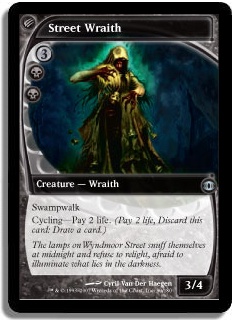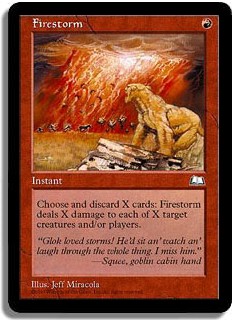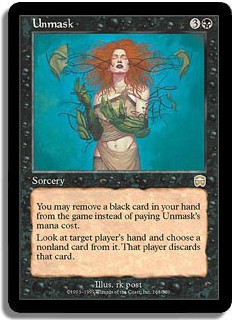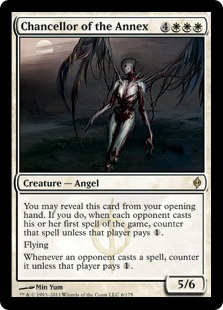I like playing Dredge.
It’s a break from “normal” Magic and often feels like you’re playing a different game than your opponent. You look at several cards per turn, most of which do things out of the graveyard like Cabal Therapy, Narcomoeba, and Ichorid. Basically, you’re casting Ancestral Recall several times per game, and none of your spells cost mana. Dredging creates lots of card advantage, which I like.
Most importantly, the games feel structured. I have a minor background in poker. I dealt for a number of years, am friends with several talented players, and have even played a little myself. I got started in no-limit Texas Hold ‘Em, but when I moved back to Minnesota, all they offered was limit games.
These days, I strongly prefer limit to no-limit, mostly because it’s structured. In no-limit, you have a lot of options in regard to bet sizing, as do your opponents, which further complicates things. In limit, it’s call/raise/fold or check/bet with a set amount. Overall, it’s much simpler and, in my eyes, much cleaner.
With Dredge, you’re trying to go through as much of your deck as possible as efficiently as possible. This means using Cephalid Coliseum on your upkeep if Golgari Grave-Troll is the only dredger in your graveyard. At least if on your dredge six you don’t hit another dredger, your Coliseum allows you to discard your Troll and dredge again in your draw step. You use your Putrid Imps to discard first then cast Careful Study or discard with Careful Study and then use Breakthrough or Cephalid Coliseum.
Once the mechanics of the deck are down, everything else should come smoothly. There is a hint of creature combat that you might have to get used to, or knowing when to attack with an Ichorid into their Shardless Agent when you know your Bridge from Belows will be exiled from your graveyard when their creature dies. After enough practice, those decisions will become second nature.
The first check/bet option comes with your opening hand. Typically, you want a discard outlet, a dredger, and the requisite resources to make that happen, such as lands. If the answer to “can I win with this hand?” is no or even uncertain, I’ll probably mulligan. Dredge can win with three card hands, so instead of thinking about how awful it feels to mulligan, think about it as checking a “yes” or “no” box.
If your hand is bad, you don’t have to mulligan—you get to mulligan. Rather than doom yourself with a bad seven- or six-card hand, you have the option to try again with a five-card hand. There are so many semi-dead cards in any sample Dredge opening hand that often you only have four or five relevant cards anyway.
Dredge, to me, is elegant and beautiful in the way it plays out. On top of that, it’s incredibly powerful and frequently feared but rarely prepared for.
While testing for the most recent Magic Online Championship Series (MOCS) season finals, which happened to be Legacy, I took a good, hard look at Dredge. Throughout my adventures on the StarCityGames.com Open Series, few decks have given me as good of a record as Dredge.
I expected the MOCS to be a strange tournament with a plethora of budget decks, as few players want to invest in Legacy on Magic Online. After last year’s Legacy MOCS, I had a lot of regrets about my choice to play RUG Delver instead of something like Reanimator, which manhandles budget decks like Burn. This year, I didn’t want to make the same mistake.
“You’re crazy for thinking about playing Dredge in a field of Deathrite Shamans.”
That type of thought is what’s wrong with Magic. While Deathrite Shaman is a good card against Dredge, it’s the type of card that lulls people into a false sense of security, leading them to board little, if any, graveyard hate. On top of that, we know who our enemy is! That’s enormously powerful information that we can utilize. Instead of shying away from Dredge in fear of Deathrite Shaman, we should learn how to fight it.
It starts with this guy:
In a typical game, they’ll play a Deathrite Shaman, and you’ll play Putrid Imp or Careful Study and discard a dredger. From my experience, 90% of the time they assume you have nothing and will use Deathrite Shaman immediately on your dredger.
That’s not necessarily a bad play, although an active Deathrite Shaman can eat Ichorids, which is Dredge’s best threat, and Dread Return targets. Eventually, you might be able to overwhelm them with threats if you keep dredging, but it’s tough. That said, I’ve played very few games where they had the patience to wait on using their Deathrite Shaman to know who’s favored in that battle.
Assuming they attempt to exile your dredger, you can discard another to Putrid Imp if you have it. If you Careful Studied, hopefully you discarded two dredgers. If not, cycle Street Wraith in response and then hopefully dredge again on your turn. At that point, your graveyard will be chock full of so many things that they won’t be able to come back.
“Well, what if you don’t draw Street Wraith in your opener?”
Hope you draw multiple dredgers so they can’t eat them all and hopefully have a very good Cephalid Coliseum or Breakthrough turn. That’s honestly not very difficult, but, as I mentioned earlier, those grindy games exist where they can exile your threats with Deathrite Shaman. To make things easier, we should probably kill it.
Firestorm obviously does work against Deathrite Shaman, but Unmask actually isn’t very good against Deathrite decks. Still, it’s an option that exists if you don’t want to play Firestorm or Street Wraith for whatever reason. It’s also incredibly good against other combo decks and things like Rest in Peace.
That brings us to this:
Creatures (27)
Lands (13)
Spells (20)

The Nature’s Claims in the sideboard could easily be Unmasks depending on whether you expect more combo or dedicated hate like Leyline of the Void. Both are good against Rest in Peace, so that’s not really an argument worth having.
The three most common matchups are those with Deathrite Shaman, those with Batterskull, and those that have little interaction and are just trying to race you. In all of those matchups, you want to fill your graveyard as quickly as possible, which is why I think Breakthrough is fantastic right now. Additionally, most people are playing Surgical Extraction over Tormod’s Crypt or Relic of Progenitus, so you can’t really get punished for doing that post-board either.
Overall, the deck was good, but my win rate was nowhere near as good as in real life. I wanted to try something else. For some reason, that something ended up being Manaless Dredge. The deck looked like it had less control over what happened per game, but I figured I had most of the cards so what the hell.
There are three things you should know about Manaless Dredge:
1) You always want to be on the draw. Since you have no hope of casting spells and your only method of starting to dredge is the draw, discard, dredge (DDD) strategy, being on the draw is the only thing that makes sense. By extension, any opponent should automatically choose to draw first. No matter what, they are going to get the first turn, but whether they start with seven or eight cards is up to them.
It was surprising how many opponents chose to play first against me simply out of instinct.
2) Since your only method of beginning the dredge chain is DDD, every mulligan is a Time Walk for your opponent. Similarly, if they are able to Thoughtseize you, that’s another Time Walk. Overall, these are not big deals because if they are Thoughtseizing you, they might have to put something good in your graveyard and they are spending their turn not doing anything.
Awkwardly enough, I’ve had people Inquisition of Kozilek me on turn 1 when the only thing they could take was a Golgari Thug. Thanks!
3) Manaless Dredge is much faster and more resilient than you could ever give it credit for simply by looking at it. Even I didn’t believe how often my opponents were conceding on turn 2.
How about a decklist?
Creatures (40)
- 4 Nether Shadow
- 4 Ichorid
- 4 Golgari Grave-Troll
- 4 Golgari Thug
- 3 Shambling Shell
- 4 Stinkweed Imp
- 4 Phantasmagorian
- 4 Narcomoeba
- 4 Street Wraith
- 2 Flayer of the Hatebound
- 3 Griselbrand
Lands (4)
Spells (16)
Sideboard

This list is a bit dated at this point, but not much needed to be changed. I started here and quickly removed the Reverent Silence package from the sideboard. I expected few Rest in Peaces and Leyline of the Voids online and wanted to make a run for other things.
For starters, Burn and Storm have large followings online. While I could kill on turn 2, Storm would get the first turn 2 and kill me first. Despite not wanting things like Leylines in Manaless Dredge because that’s a Time Walk for your opponent, such measures had to be taken in order to interact with Storm before they got their third turn. Several people have disagreed with me on that, insisting that Storm was a fine matchup. From my experience, I’d draw, discard, and then die.
Contagion and Sickening Shoal weren’t entirely relevant against Deathrite Shaman since I could beat them with the aforementioned Street Wraith. Phantasmagorian also helps by allowing you to put multiple dredgers into the graveyard at the same time. Killing Deathrite Shaman is a nice luxury to have, but if you don’t have Street Wraith or Phantasmagorian, do you just exile two cards and hope they don’t have a fast draw? That’s fine but not very exciting. I wanted something better.
Chancellor of the Annex is exactly what I needed. It delays Storm for a turn, delays Deathrite Shaman until I’ve already dredged once, and even prevents them from putting me in the Relic of Progenitus lock on turn 1. It even functions as a fine Dread Return target against most decks.
That led to me playing this in the MOCS:
Creatures (44)
- 4 Nether Shadow
- 4 Ichorid
- 4 Golgari Grave-Troll
- 4 Golgari Thug
- 4 Shambling Shell
- 4 Stinkweed Imp
- 4 Phantasmagorian
- 4 Narcomoeba
- 4 Street Wraith
- 4 Chancellor of the Annex
- 1 Flayer of the Hatebound
- 3 Griselbrand
Lands (4)
Spells (12)
Sideboard

Adding the sixteenth dredger was a no-brainer. Out of the 50 or 60 matches I’d played, I’d had thirteen hands with no dredger, which is certainly not a recipe for success. There are very few instances in which I’d mulligan, as your odds of drawing a dredger in the first turn or two are better than mulliganing and hoping to win. Awkwardly enough, that’s the opposite of the other Dredge deck. There was no reason not to play the full sixteen.
The second Flayer is completely unnecessary. If you Dread Return Griselbrand, you are going to draw your deck, Dread Return Flayer, then Dread Return Golgari Grave-Troll for lethal. There is no reason to play a second Flayer. Similarly, using Dread Return on Griselbrand isn’t necessary in most matchups, but it’s very relevant against decks like Esper Stoneblade. However, you don’t need to do it early, and against the fast decks, Chancellor of the Annex is often good enough.
I tinkered with the numbers of Nether Shadow and Dryad Arbor, and I’m still not sure what’s correct. Both speed the deck up, but I toyed with Gitaxian Probe and Call to the Netherworld for speed as well. In the end, Call was too situational, and both ran the risk of being countered.
Other than that, what the deck is doing is very good right now, barring any strange pairings. The core is very strong.
For the sideboard, I had Mindbreak Trap and Leyline of Sanctity to slow down Storm. Chalice of the Void was another option, but Leyline doubled as hate against Burn. Not only would it make racing easy against them, but it took much of the brunt away from their best sideboard card (Relic of Progenitus). The removal spells were for Deathrite Shaman and various problematic creatures like Scavenging Ooze and Elesh Norn, Grand Cenobite. I did, in fact, Sickening Shoal Todd Anderson Elesh Norn, as Phantasmagorian conveniently costs seven.
More Storm hate or enchantment removal might be more important, though, depending on what you expect to play against.
Going forward, I would cut one Griselbrand, maybe one Nether Shadow, and maybe one Dread Return. Sickening Shoal (which I prefer over Contagion) could take their spot, or you could play Gitaxian Probe.
“So how did you do in the MOCS?”
I won some, lost some, and had a very marginal tournament. Yet again, I was left wondering why I didn’t play Reanimator. Not only did it win the tournament, but Todd Anderson finished a heartbreaking 9th with it. It’s just so good against the Magic Online metagame.
***
This isn’t a comprehensive guide to Dredge or anything, so if there are any specific questions you have that I didn’t answer, I’d be more than happy to address them in the comments section. As always, I’d prefer to answer questions about literally anything other than how to sideboard, but if I have enough time, I’ll get to those too.
For real life, I’m probably done with BUG for a while. I’d like to try the Dream Halls deck with Enter the Infinite since it now has several redundant combo pieces. There are also a couple builds of Aluren I’ve been toying with, but there’s nothing exciting enough to make me want to play it yet.
I certainly didn’t win the MOCS, but that’s ok. At the end of all this, I have a new(ish) deck that I can now wield proficiently. I also have plenty of memories of absurd Legacy moments, both fond and otherwise, and a sizable collection of Return to Ravnica boosters. And I will never look at this question the same again:
“Would you like to play or draw?”
GerryT
@G3RRYT on Twitter




